Walleye begin their spawning journey up Scriba Creek to the hatchery in Constantia, NY.
Posted April 12, 2019. Video provided by Erika Stoddard
The Oneida Lake Fish Cultural Station is open from April 1 to September 30 - seven days a week from 8 a.m. to 3:30 p.m. The adult walleye collection in April is an interesting attraction to the public since large adult walleyes can be viewed at the hatchery. Tour guides will be available at this time. Group tours can be arranged by contacting the hatchery.

Directions: Take Interstate 81 to Exit 32 (Central Square). Turn onto NYS Route 49 and head east for about 8 miles.
The hatchery is located on the north side of the road, just over the bridge in the village of Constantia.

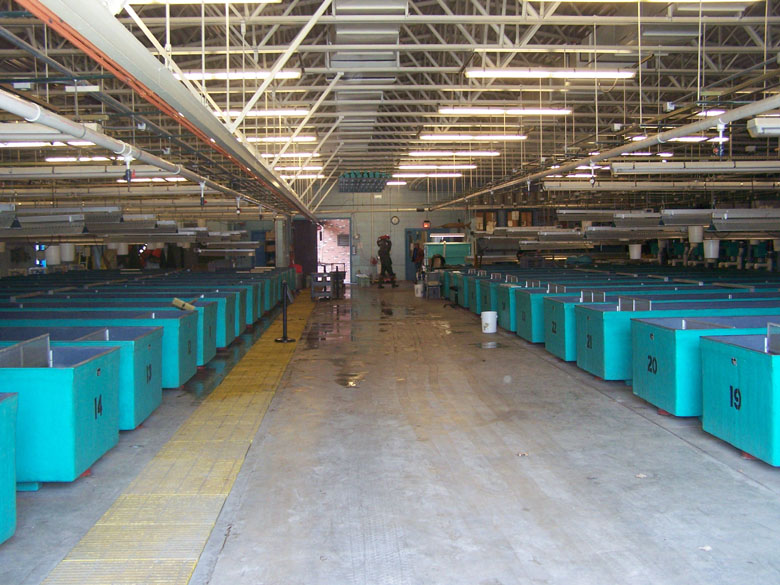
Various life stages of walleye are present at the hatchey from April through September. Adult fish are present from mid-April to early May.
From early May to July you can view small fish. Fingerlings are present from July to mid-September.
In addition, visitors can view a display of other species of Oneida Lake fish in the visitors' center.
Tours for organized groups may be arranged in advance by contacting the hatchery manager at (315) 623-7311.
The Oneida Fish Culture Station specializes in raising walleye, but occasionally raises such rare fish as lake sturgeon, paddlefish and round whitefish.
One of the newer facilities, the current hatchery was completed in May 1993 and includes modern rearing facilities as well as a research lab and visitors center.
Each year, Oneida Lake produces an average of 200 million walleye fry (newly hatched fish) and 300,000 walleye fingerlings (4" - 6" long). These fish are raised specifically for stocking Oneida Lake and several other public waters throughout New York State. This effort includes the restoration of self-sustaining and abundant walleye population in 33 waters, introduction and establishment of new walleye population in 21 waters, and an increase of walleye abundance in 89 existing fisheries.

Trap nets are laid out on the parking lot to inspect for any damage that needs to be repaired.

The fish cultural station has plenty of free parking and utilizes a computer controlled environment.

Trap nets are untangled, repaired, dried, folded, and put in dry storage for the next season.
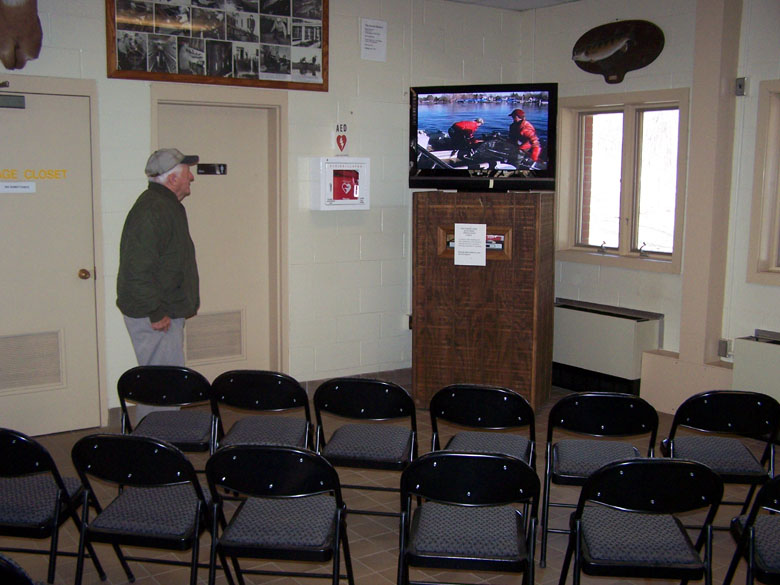
DVD on the wide screen TV contains some video clips showing different stages of the process.
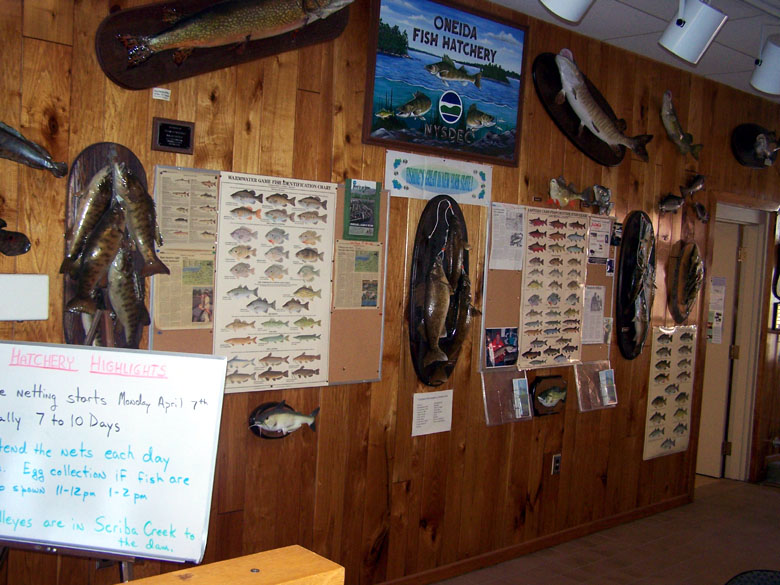
Many trophy sized fish mounts are on public display. These include all of the fresh water game fish and pan fish available in Oneida Lake.
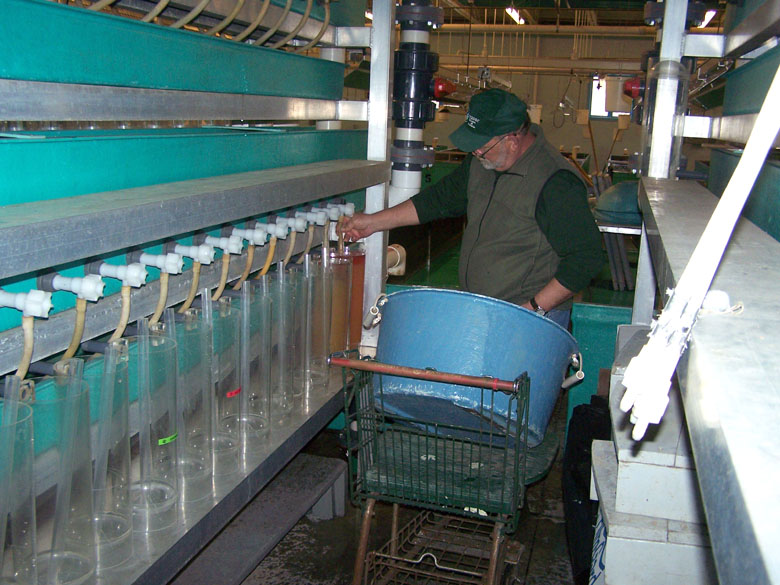
A worker is filling the incubation jars from a tub of prepared eggs. A special dye is used to harden the eggs.
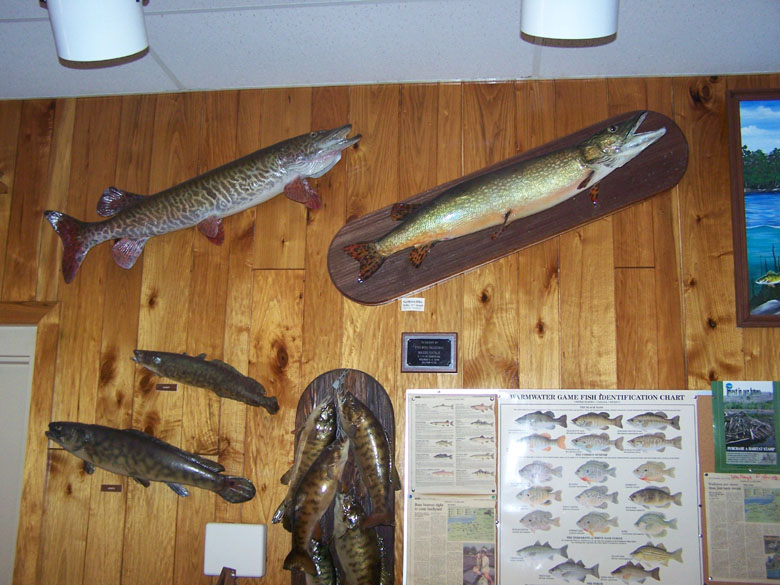
Walleye raised at this hatchery develop from eggs taken from adult fish captured in trap nets set on Oneida Lake.
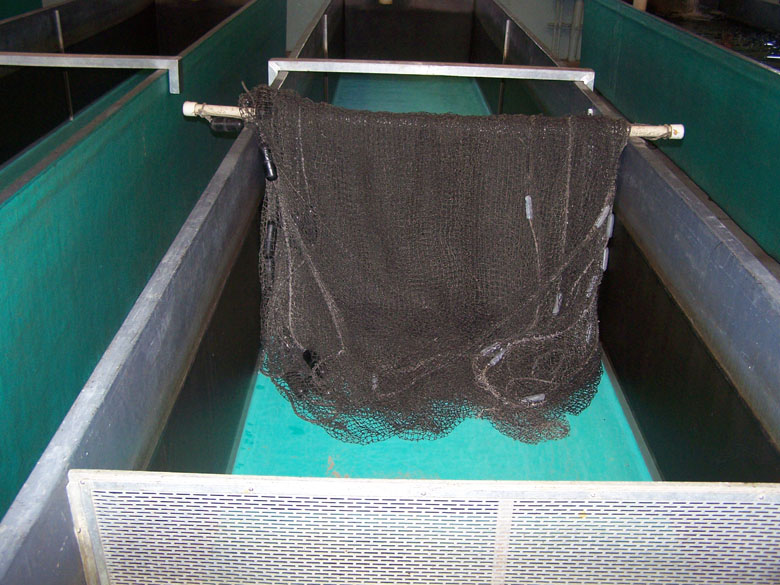
Each year hatchery personnel collect an average of 350 million walleye eggs.
The fish are taken to the hatchery by boat and then spawned, a process where eggs are gently squeezed from mature females and fertilized by mature males. Once the fertilized eggs are obtained, the adult fish are returned to the lake unharmed.
Eggs are placed in hatching jars that are supplied with a constant flow of water. The water temperature is what determines the amount of time it takes for the eggs to develop. When the eggs hatch, the emergents (called sac fry) swim up and out of the jars and travel down a trough into rearing units. At first, these tiny fry are nourished by the yolk sac that protudes from their abdominal region.
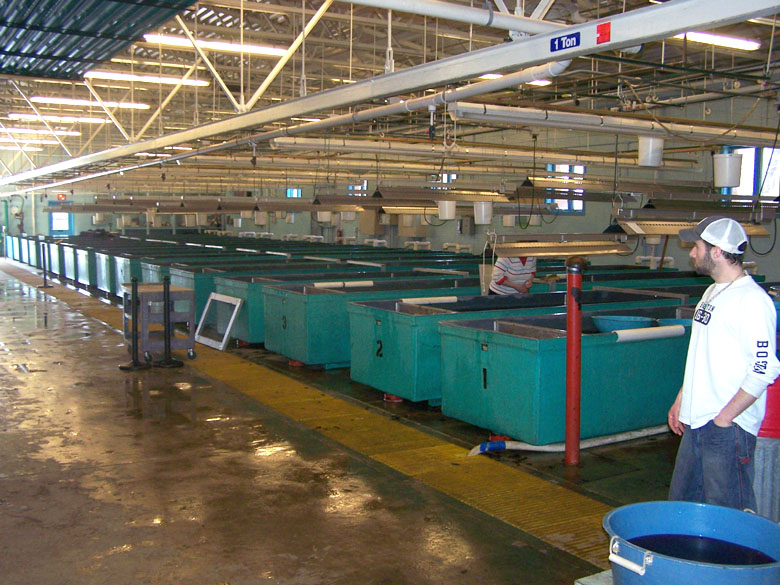
When the sac fry are 3 days old, brineshrimp are provided for nourishment. The shrimp are delivered automatically from hoppers set at the end of each rearing unit. Newly hatched sac fry are fed brineshrimp for a total of 44 days.
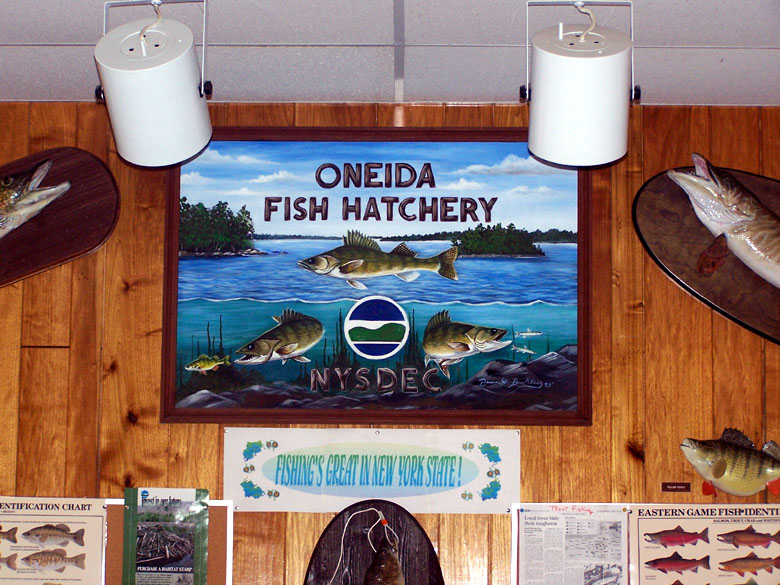
In addition to the brineshrimp, dry food is also delivered by automatic feeders beginning at day 30. The brineshrimp and dry food are fed simultaneously for 14 days, at which time the brineshrimp are stopped. All food is dispensed at 5 minute intervals around the clock.
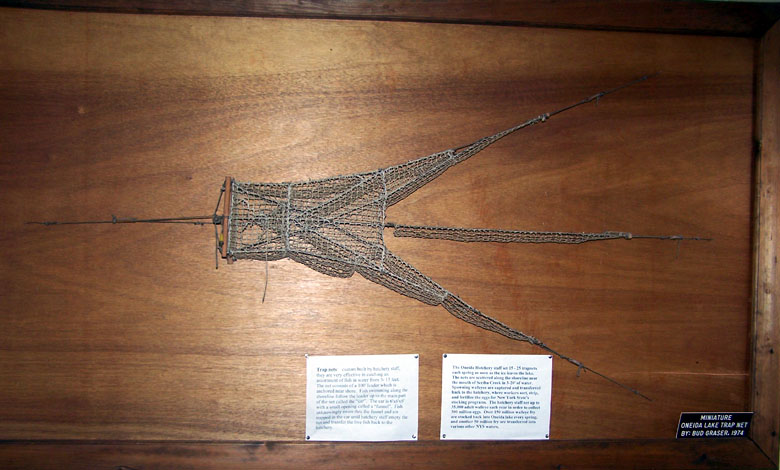
Since dry diets are available in a variety of food sizes, the size can be increased accordingly as the fish continue to grow. The amount of food to be fed each day is also adjusted as necessary to assure optimum growth and development. As the fish grow, the amount of space necessary to rear them increases.

The initial rearing stage requires the use of 24 raceways. By the time the fish reach the fingerling stage, a total of 32 raceways will be used. Each raceway is vacuumed daily to remove accumulated fish waste.
To ensure the fish grow properly and stay healthy, routine samples of the fish are taken to access rate of growth and overall condition. In addition, fish are monitored each day for health problems.
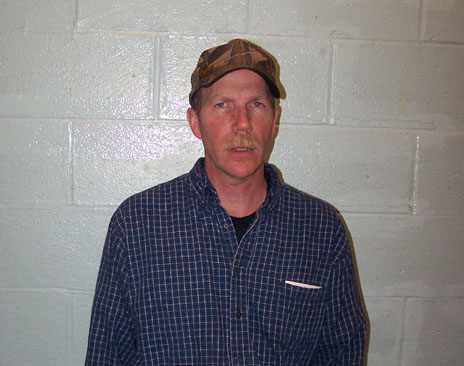
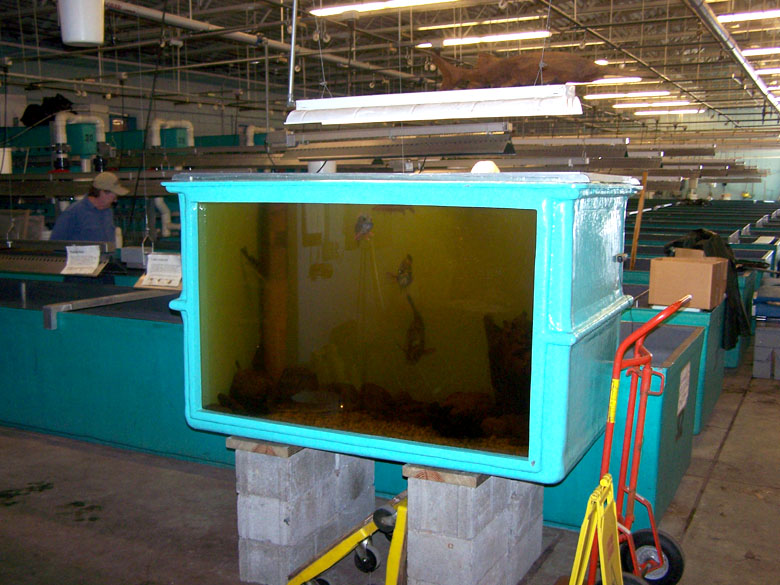
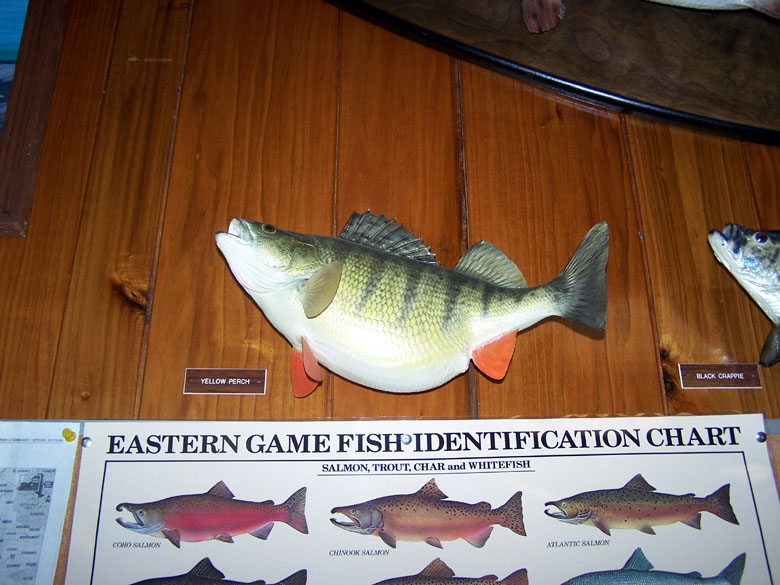

Statistics and Specifications: Site Acreage: 4 - 5 acres. Main building is 80' x 240'. Water Supply: Scriba Creek, by gravity, from a concrete dam located 1/3 mile above the hatchery. There is approximately 8 feet of head in the rearing room of the hatchery. The facility can be supplied with up to 1800 GPM (gallons per minute) of water.
Chronological History:
1893 - The first eggs were collected. 1895 - The first hatchery was built on Frederick Creek. 1942 - The building was erected on the present site. 1992 - The facility was completely overhauled to presetn building at a cost of $3.15 million.




Description by Room:
Electrical Room: All power to the building enters in this room - the system and voltage available is 120/208 volts, 3 phase, four wire, 60 hertz. Also in this room is a diesal generator capable of supplying emergency power to most of the hatchery. This generator can supply up to 150 kw of power.
Filter and Clear Well Room: Water enters the building here and can be filtered at this point. Water should be filtered during the fish rearing phase; it is less important during egg take and incubation. Water to be filtered must pass through a large rotary drum with 120 micron screen panels. This drum has a continuous back wash to clean the screens. Filtered water collects in the clear well and continues by gravity through the hatchery. Unfiltered or surplus water is by-passed to the creek. If the filter screens become plugged, unfiltered water can be delivered to the hatchery.
Ultraviolet Sterilization and Oxygen Injection Room: Water enters this room and passes a UV sterilization unit capable of treating 1800 GPM of water flow. This unit is effective in reducing the amount of bacteria that is present in the water supply by 99%. Dissolved oxygen can be injected into the water using aquatectors. This system is capable of increasing dissolved oxygen in rearing water (1800 GPM) by two parts per million. Use of this system can become necessary when rearing temperatures become high (e.g. 75° F+).
Boiler Room: Propane fired boilers supply energy for heating the building and cultural water. A minimum rearing temperature of 55° is necessary to start walleye fry feeding on brineshrimp. Cultural water passes through heat exchangers which increases its temperature, then passes through a mixing valve and a packed column to remove excess gas, and injected into unheated creek water. The cultural boilers are capable of increasing the temperature of the rearing water (300 GPM) by 5° - 7°.




Research Wing: Nine rectangular rearing units and four circular tanks with a lab for research directed at improving cultural techniques.
Visitors Center: Lobby with displays that describe hatchery history, video tape of hatchery operation, numerous adult fish wall mounts, and a viewing area that allows visitors to see fish being unloaded from boats.




Rearing Wing: Broodstock and egg collection: Adult fish are collected in 12 - 15 trap nets set in Oneida Lake. Adults are transported to the hatchery via boat in large tubs. Tubs of adult fish are removed from the boat with an electric hoist and transferred onto dollies, then taken to the holding tanks. Fish are hand sorted as follows: male, ripe female (capable of being stripped for eggs), or hard female (fish with eggs not ready to strip). Eggs from ripe fish are collected on the day they are brought in from the lake. Hard females held in the hatchery are checked each day. When they become ripe, they are added to other ripe fish and stripped that day. To collect 400 million eggs, we handle close to 40,000 adult walleyes. This usually happens over an 8 - 12 day period after ice-out in early April.
Fingerling Rearing: The hatchery has 32 standard rearing units that are 25' x 4' x 2.5'; interior sides of these units are dark gray, the bottom is blue. These tanks are used for all phases of walleye production: about 22 tanks are used to hold adult fish during the annual run, 13 tanks are set up for fry collection, 28 tanks are used to start walleye fry on brineshrimp. These tanks are equipped with automatic brineshrimp feeders, specialized high intensity fluorescent lighting and Loudon automatic feeders to dispense formulated diet. Close to two million fry are started in these tanks. The 4 remaining tanks are used to thin walleyes at a later date and are equipped with only Loudon feeders.




Egg Incubation: Thirteen jar batteries, each with approximately 70 hatching jars, supplied with 75 GPM water. Three quarts of eggs (450,000) are placed in each jar. Total hatchery capacity for hatching 4,000,000 eggs with an incubation period on average of 21 days.
Fry Collection: Water from each jar battery flows to a fry collection tank. Fry swim from the jar and gather in the collection unit. Fry are removed from the collection units and stocked each day during the hatching period which usually lasts 5 - 7 days.
Brineshrimp Production: Fifteen - 60 gallon circular, insulated drums; each supplied with a submersible aquarium heater (for 80° - 85° F water), large volume aerators, and lights above. Air is supplied from two 3/4 horsepower air pumps.




Feeding: Brineshrimp feeders are filled twice each day at a rate that will supply 700 shrimp per fish, per day. Brineshrimp is dispensed from the feeders at 5 minute intervals around the clock. Brineshrimp is fed for the first 40 - 50 days. It takes 1,000 pounds of brineshrimp cysts to feed 1 million walleye fry for 50 days. Formulated (dry) diet is introduced on day 30 and fed for the remainder of the season from the Loudon feeders. This diet is introduced initially at 5 minute intervals around the clock. Each year, approximately 15,000 pounds of dry diet is fed.
Fish Feeders: All feeders are controlled by timers which allow them to operate 24 hours per day at specific intervals.




Lights: Lighting is operated manually as needed.
Cleaning: Vacuum air system is used to clean rearing tanks each day. Fish waste and unused fish food goes directly to septic tanks with subsurface leech fields.
Water: Up to 70 GPM of water can be supplied to each rearing unit.
Fish Density: At this facility, walleye fingerlings can be held at densities of 1.5 pounds of fish per cubic foot of water when converted to formulated diets.








